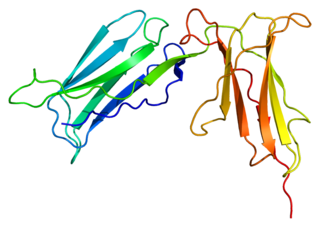
Complement receptor type 2 (CR2), also known as complement C3d receptor, Epstein-Barr virus receptor, and CD21, is a protein that in humans is encoded by the CR2 gene.

Chemokine receptor 6 also known as CCR6 is a CC chemokine receptor protein which in humans is encoded by the CCR6 gene. CCR6 has also recently been designated CD196. The gene is located on the long arm of Chromosome 6 (6q27) on the Watson (plus) strand. It is 139,737 bases long and encodes a protein of 374 amino acids.

C-type lectin domain family 4 member M is a protein that in humans is encoded by the CLEC4M gene. CLEC4M has also been designated as CD299.

CD244 also known as 2B4 or SLAMF4 is a protein that in humans is encoded by the CD244 gene.

Killer cell immunoglobulin-like receptor 3DL1 is a protein that in humans is encoded by the KIR3DL1 gene.

Killer cell immunoglobulin-like receptor 2DL4 is a protein that in humans is encoded by the KIR2DL4 gene.

Decoy receptor 3 (Dcr3), also known as tumor necrosis factor receptor superfamily member 6B (TNFRSF6B), TR6 and M68, is a soluble protein of the tumor necrosis factor receptor superfamily which inhibits Fas ligand-induced apoptosis.

C-type lectin domain family 7 member A or Dectin-1 is a protein that in humans is encoded by the CLEC7A gene. CLEC7A is a member of the C-type lectin/C-type lectin-like domain (CTL/CTLD) superfamily. The encoded glycoprotein is a small type II membrane receptor with an extracellular C-type lectin-like domain fold and a cytoplasmic domain with a partial immunoreceptor tyrosine-based activation motif. It functions as a pattern-recognition receptor for a variety of β-1,3-linked and β-1,6-linked glucans from fungi and plants, and in this way plays a role in innate immune response. Expression is found on myeloid dendritic cells, monocytes, macrophages and B cells. Alternate transcriptional splice variants, encoding different isoforms, have been characterized. This gene is closely linked to other CTL/CTLD superfamily members on chromosome 12p13 in the natural killer gene complex region.

NKG2-F type II integral membrane protein is a protein that in humans is encoded by the KLRC4 gene.

Killer cell immunoglobulin-like receptor 3DL2 is a protein that in humans is encoded by the KIR3DL2 gene.

Sialic acid-binding Ig-like lectin 7 is a protein that in humans is encoded by the SIGLEC7 gene. SIGLEC7 has also been designated as CD328.

Killer cell lectin-like receptor subfamily B, member 1, also known as KLRB1, NKR-P1A or CD161, is a human gene.

Killer cell immunoglobulin-like receptor 2DS4 is a protein that in humans is encoded by the KIR2DS4 gene.

Natural cytotoxicity triggering receptor 2 is a protein that in humans is encoded by the NCR2 gene. NCR2 has also been designated as CD336, NKp44, NKP44; NK-p44, LY95, and dJ149M18.1.

C-type lectin domain family 1 member B is a protein that in humans is encoded by the CLEC1B gene.

Leukocyte immunoglobulin-like receptor subfamily A member 2 is a protein that in humans is encoded by the LILRA2 gene.

Osteoclast-associated immunoglobulin-like receptor is a protein that in humans is encoded by the OSCAR gene.

C-type lectin domain family 4 member A is a protein that in humans is encoded by the CLEC4A gene.

C-type lectin domain family 12 member A is a protein that in humans is encoded by the CLEC12A gene.

C-type lectin domain family 10 member A (CLEC10A) also designated as CD301 is a protein that in humans is encoded by the CLEC10A gene. CLEC10A is part of the C-type lectin superfamily and binds to N-Acetylgalactosamine (GalNAc). It is mainly expressed on myeloid cells and also on oocytes and very early stages of embryogenesis. CLEC10A is used as a marker of the CD1c+ dendritic cell subgroup, also called cDC2. The actions of CLEC10A are diverse, depending on the ligand and environment.














